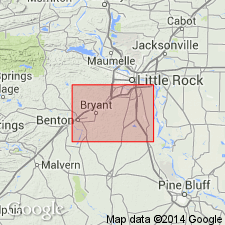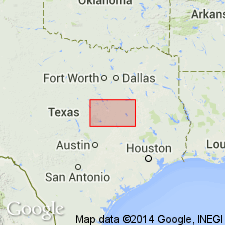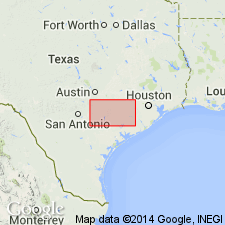
- Usage in publication:
-
- Littig glauconite member*
- Modifications:
-
- Original reference
- Dominant lithology:
-
- Sand
- AAPG geologic province:
-
- Ouachita folded belt
Summary:
Pg. 530, 535, 536, 550, 554. Littig glauconite member of Kincaid formation of Midway group. A bed of greenish-black, calcareous, glauconitic sand, from 8 inches to 15 or moree feet thick, forming basal member of Kincaid formation. Underlies Pisgah member. Weathers yellowish green or buff; contains phosphate nodules, small pebbles, shark's teeth, casts of fossils, and spherical calcareous concretions. Age is Eocene.
Type locality: in the road 1.5 mi by road south-southwest of Littig, on south side of Wilbarger Creek, [Elgin West 7.5-min quadrangle], Travis Co., eastern TX; see also H.J. Plummer, 1927, Univ. Texas Bull., no. 2644, pl. 1, sta. 61.
Source: Publication; US geologic names lexicon (USGS Bull. 896, p. 1193).

- Usage in publication:
-
- Littig glauconitic member*
- Modifications:
-
- Areal extent
- AAPG geologic province:
-
- East Texas basin
Summary:
Pg. 13. Littig glauconitic member of Kincaid formation of Midway group. In Texas, is basal member of Kincaid. Underlies Pisgah member. In southwestern Arkansas beds of highly glauconitic and phosphatic sand, probably representing the Littig, crop out at a few localities in eastern Hempstead and western Nevada Counties where they disconformably overlie the Arkadelphia marl. Age is Paleocene.
Source: Publication; US geologic names lexicon (USGS Bull. 1200, p. 2185).
- Usage in publication:
-
- Littig member
- Modifications:
-
- Biostratigraphic dating
- AAPG geologic province:
-
- East Texas basin
Kellough, G.R., 1959, Biostratigraphic and paleoecologic study of Midway Foraminifera along Tehuacana Creek, Limestone County, Texas: Gulf Coast Association of Geological Societies Transactions, v. 9, p. 147-160.
Summary:
Pg. 150-152. Littig member of Kincaid formation of Midway group. Consists of dark-green sandy shale with streaks of sandstone containing much coarse elongate to free-form dark-green glauconite, shell fragments, fish teeth, phosphate, pebbles, coprolites, and Foraminifera. Thickness 7 feet. Is basal member of Kincaid formation. Underlies Pisgah member; unconformably overlies Upper Cretaceous Navarro formation. [Foraminifera listed.] The Littig lies in [locally defined] ALABAMINA MIDWAYENSIS LIMBATA zonule, [in lower part of] GLOBIGERINA COMPRESSA-DAUBJERGENSIS zone of Loeblich and Tappan (1957, p. 173-177). Lower part of member carries some reworked Cretaceous Foraminifera, mostly GLOBIGERINIDAE and HETEROHELICIDAE. Age is early Paleocene (Danian; Midwayan Provincial Age).
Source: Publication; US geologic names lexicon (USGS Bull. 1200, p. 2185).

- Usage in publication:
-
- Littig Member
- Modifications:
-
- Areal extent
- AAPG geologic province:
-
- East Texas basin
Summary:
Littig Member of Kincaid Formation of Midway Group. Basal member of formation. Sand and Clay; sand very glauconitic, greenish black; clay, sandy, phosphatic nodules and pebbles present; weathers to yellow and yellowish-brown soil. thickness 10 to 120 feet, thins locally, forms mid-slope of cuesta formed by Tehuacama Member of Kincaid. Lies above Kemp Clay (Upper Cretaceous) and below Pisgah Member of Kincaid. Age is Eocene.
Not separately mapped. (Pisgah and Littig Members [undifferentiated] of Kincaid mapped in Falls, Limestone, and Navarro Cos., eastern TX.)
Source: Publication.

- Usage in publication:
-
- Littig Member
- Modifications:
-
- Areal extent
- AAPG geologic province:
-
- Gulf Coast basin
Summary:
Littig Member of Kincaid Formation of Midway Group. Sand and clay; sand, very glauconitic, greenish black; clay, sandy, phosphatic nodules and pebbles present; weathers to yellow and yellowish-brown soil. Overlies Navarro Group (Upper Cretaceous); underlies Pisgah Member. Age is Eocene.
Not separately mapped. (Midway Group undivided mapped in Guadalupe and Caldwell Cos., southeastern TX.)
Source: Modified from GNU records (USGS DDS-6; Denver GNULEX).

- Usage in publication:
-
- Littig Member
- Modifications:
-
- Areal extent
- Dominant lithology:
-
- Sand
- Clay
- Limestone
- AAPG geologic province:
-
- Ouachita folded belt
Summary:
Pamphlet [p. 4]. Littig Member of Kincaid Formation of Midway Group. Sand, clay, and limestone; sand very glauconitic, greenish black; clay, sandy, phosphatic nodules and pebbles present; limestone, very glauconitic, sandy, fossiliferous; weathers to yellow and yellowish brown soil. Is basal member of Kincaid Formation. Lies below Pisgah Member of Kincaid Formation and above Upper Cretaceous Escondido Formation. Age is Eocene.
Not separately mapped. [Pisgah and Littig Members, undifferentiated, mapped as small outlier along tributary of Nueces River, southeast of Sulphur Mountain, southern Uvalde Co., southern TX; southwestern corner of map sheet.]
Source: Publication.
For more information, please contact Nancy Stamm, Geologic Names Committee Secretary.
Asterisk (*) indicates published by U.S. Geological Survey authors.
"No current usage" (†) implies that a name has been abandoned or has fallen into disuse. Former usage and, if known, replacement name given in parentheses ( ).
Slash (/) indicates name conflicts with nomenclatural guidelines (CSN, 1933; ACSN, 1961, 1970; NACSN, 1983, 2005, 2021). May be explained within brackets ([ ]).

